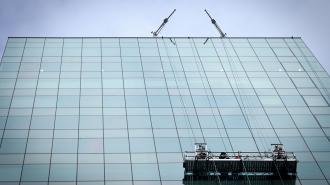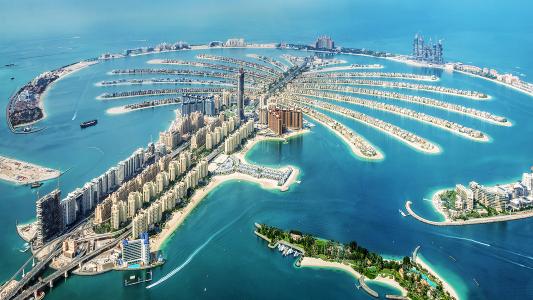Hanging high and tight to the gleaming surfaces of our tallest buildings, high-rise window cleaners are a unique and iconic element of urban life.
They may also be robots soon.
Two Israeli startups are racing to replace window cleaners with robots they say can do the job faster and safer than human beings. Verobotics and Skyline Robotics, both based in Tel Aviv, will soon be taking their two different approaches to sci-fi scrubbing to the definitive heights of Hong Kong and New York.
The world of window cleaning “basically hasn’t changed in the last 100 years,” says Ido Genosar — a former construction worker and co-founder and CEO of Verobotics — according to Axios.
Two Israeli startups are racing to replace window cleaners with robots they say can do the job faster and safer than human beings.
Skyline CEO and chairman Michael Brown noticed the same thing by looking up.
“I was driving in New York City, which obviously has a tremendous number of tall buildings,” Brown told the Israeli tech site NoCamels. “And I said to myself, I cannot believe people are still cleaning windows by hand. Why are they not using robots?”
The shakeup may not just be overdue from a classic tech perspective; the current generation of highly-trained workers who currently make the sky sparkle are getting older and heading towards retirement age, Genosar and Brown told Axios.
Window pains: While better regulations and safety equipment increasingly ensure that high-rise window cleaners rarely die during the course of duty, the inherent danger and tedium of the job is making finding new candidates to replace the old guard — and deadly accidents do still happen.
“Cleaning windows is the worst job in the world,” Brown insists to NoCamels. (Although not all window cleaners agree.)
“It is so dangerous the heat is not to be believed. You’ve got the sun coming off of the windows, and you literally feel like you’re in an oven.”
From the building owner’s likely more comfortable (although less dazzling) perspective, it is also time-consuming and expensive.
“Many high-rise buildings can only afford about two annual cleaning cycles and each cycle can take up to four months, while our device will take about a month and can be used cost-effectively four to six times per year,” Genosar told the Times of Israel.
Robotic window cleaners can also work at night, potentially allowing for continuous, year-round upkeep, Genosar told Axios.
There’s been some similar attempts at robotic window cleaners over the years. As early as 2014, Roombas-for-windows for domestic use and automated scrubbers capable of working on smaller commercial buildings have been available. And window washing drones exist as well, Axios pointed out.
But these all have their downsides: the domestic devices weren’t made for skyscraper-sized jobs, and those older automated models were limited to around 10 stories or less and needed all glass surfaces. Drones don’t work well in cities or at high altitudes due to wind, safety concerns, and a lack of water pressure, Brown told Axios.
Bring on the bots: Skyline and Verobotics have taken two fairly different approaches to their robotic window cleaners.
Skyline, which bills its bot Ozmo as the world’s first for high-rises, uses the same window and maintenance basket that’s hoisting human window cleaners now. From that platform, Ozmo uses its six arms to wield deionized water and a suite of sensor-informed brushes for applying just the right pressure to get a streak-free clean.
Under current regulations, Ozmo’s operation will likely require two people, Axios reported; one to sit beside the bot in the basket, and the other to operate the crane from the roof.
In comparison is Verobotics’ “Spider-Man” approach. Their little 20-pound, brush-bearing robot is lowered from the roof and then “literally walking vertically on the window using suction cups,” Genosar told Axios.
The robot does not use any liquids but instead relies on the mechanical force of brush against glass, while also carrying sensors for inspection and predictive maintenance.
“Our vision eventually is to build a completely autonomous platform,” Genosar said in a video produced by Intel’s Ignite accelerator program. “We are going to do a one-time installation on the roof, and the robot will be completely independent.”
The robot window cleaners’ true potential may lie in inspection and maintenance. Using LIDAR to map building surfaces, these machines could potentially scan for structural issues or pinpoint places where leaking is happening.
“By adding a couple of cameras, we can tell you if you have window cracks, if you have HVAC leaks,” Brown told Axios. “We’re going to be able to give you real-time data — that’s information that no one ever had before.”
Bot in the big city: Robotic window cleaners could be a broader feature of urban life soon.
Skyline’s Ozmo has gotten financial backing from the venture arm of The Durst Organization, which owns some of the most famous towering buildings in New York, including 1 Bryant Park, 7 World Trade Center, and the 1,176-foot One World Trade Center, the tallest building in the Western hemisphere.
The robot window cleaners’ true potential may lie in inspection and maintenance, potentially scanning for structural issues or pinpointing places where HVAC leaking is happening.
“We’re rolling it out very strategically with the largest building developers in New York first,” Brown told NoCamels. “Because New York is the most regulated market, in the world, for work at heights.”
Skyline also has a deal with the largest commercial window washing firm in New York, Platinum, Axios reported, pairing their robot to work in combination with human window cleaners.
NoCamels estimates that there are 68,000 buildings worldwide tall enough for the basket Ozmo uses, and Brown’s also interested in breaking into Dubai, well-known for its sawtoothed, super-scraping skyline — including the world’s tallest building, the Burj Khalifa.
For their part, Verobotics recently announced a multi-million dollar deal with Hong Kong’s Robocore to distribute their robots.
“With the largest concentration of high-rise buildings in the world, Verobotics solutions are especially relevant for Hong Kong,” Robocore CEO Roy Lim told the Jerusalem Post. “We are confident that the robots will be deployed on hundreds of buildings within a couple of years.”
We’d love to hear from you! If you have a comment about this article or if you have a tip for a future Freethink story, please email us at [email protected].






